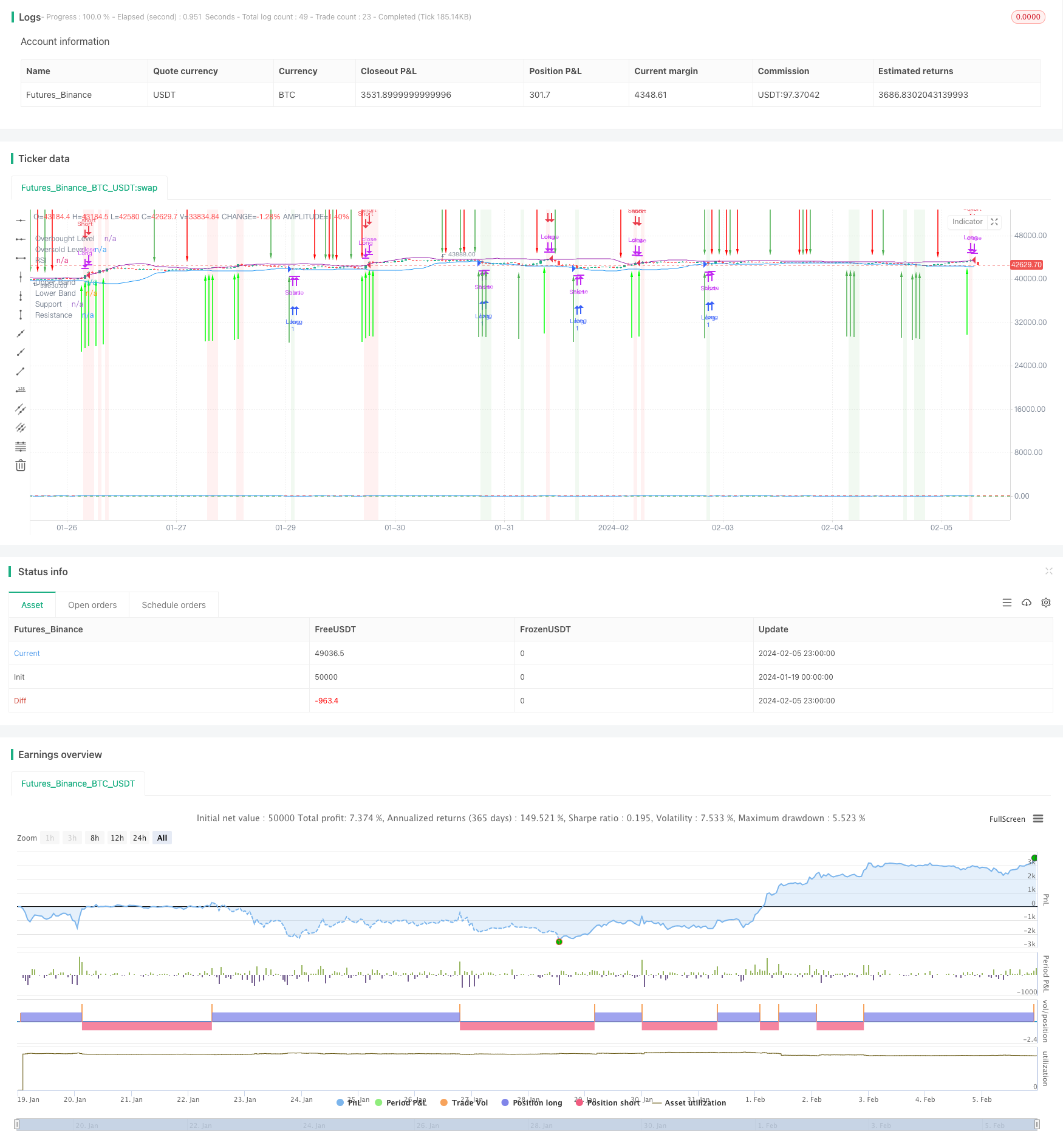Rational Trading Robot Powered by RSI Strategy
Author: ChaoZhang, Date: 2024-02-19 14:43:34Tags:

Overview
This trading strategy incorporates three robust technical indicators - Relative Strength Index (RSI), Bollinger Bands and Support/Resistance levels to enable automated trading decisions. The robot can intelligently identify potential entry and exit points based on prevailing market conditions without manual intervention.
Strategy Logic
The core logic of this trading robot is built upon RSI, Bollinger Bands and Support/Resistance analysis.
Firstly, RSI gauges the strength of the ongoing trend. RSI above 70 implies an overbought market while RSI below 30 suggests an oversold market.
Secondly, Bollinger Bands define the volatility range of the market. The upper and lower bands encompass the normal fluctuation range of the market. Touching the upper band suggests a relatively high zone where a downside reversal is likely. Likewise, touching the lower band indicates a relatively low zone where an upside bounce is expected.
Finally, Support and Resistance levels can be derived from the Bollinger Bands. Support resides around the lower band while Resistance hovers around the upper band. This implies that an uptrend may encounter selling pressure around the Resistance, leading to a potential dip. Conversely, a downtrend may meet buying demand around the Support, prompting a technical rebound.
By consolidating these indicators, the entry logic is defined as: go long when the price touches the lower band (oversold zone) coinciding with the Support; go short when the price breaches above the upper band (overbought zone) with the high exceeding the Resistance. The exit logic is governed by the directional change of the moving average.
Key Benefits
Robust signal reliability via combining multiple indicators
Fully automated execution without manual interference
Real-time alerts for instant updates on the go
Intuitive chart annotations to visualize trade levels
Customizable parameters for optimization across instruments and timeframes
Risk Control
Exceptional volatility may incur stop loss. Reasonable stop loss levels can help limit maximum loss.
Suboptimal parameter tuning may lead to overtrading or poor signal quality. Parameters should be fine-tuned based on backtest results for optimum setting.
System failure may cause signal outage or execution delays. A resilient connection and computing infrastructure is critical.
Enhancement Opportunities
Incorporate stop loss logic to further restrict downside risk.
Introduce position sizing rules according to account equity for more intelligent risk management.
Leverage machine learning by training the model on historical data to improve predictive capabilities.
Conduct parametric optimization across various products to uncover the best parameter sets tailored to each product.
Conclusion
The strategy demonstrates strong adaptability and versatility. By monitoring multiple indicators to assess market conditions, it can reliably pinpoint trend reversal levels for automated execution. Continual improvements to the algorithm will elevate strategy performance to consistently generate alpha. An excelent algo-trading solution suitable for quantitative trading.
/*backtest
start: 2024-01-19 00:00:00
end: 2024-02-06 00:00:00
period: 1h
basePeriod: 15m
exchanges: [{"eid":"Futures_Binance","currency":"BTC_USDT"}]
*/
//@version=4
strategy("RSI, Bollinger Bands, and Support/Resistance Trading Bot", overlay=true)
// Define RSI parameters
rsiLength = input(14, title="RSI Length")
rsiOverbought = input(70, title="Overbought Level")
rsiOversold = input(30, title="Oversold Level")
// Define Bollinger Bands parameters
bbLength = input(20, title="Bollinger Bands Length")
bbMultiplier = input(2, title="Bollinger Bands Multiplier")
// Calculate RSI
rsiValue = rsi(close, rsiLength)
// Calculate Bollinger Bands
basis = sma(close, bbLength)
upperBand = basis + bbMultiplier * stdev(close, bbLength)
lowerBand = basis - bbMultiplier * stdev(close, bbLength)
// Calculate Support and Resistance based on Bollinger Bands
support = basis - bbMultiplier * stdev(close, bbLength)
resistance = basis + bbMultiplier * stdev(close, bbLength)
// Strategy logic
rsiCondition = rsiValue > rsiOverbought or rsiValue < rsiOversold
touchingUpperBand = close >= upperBand
touchingLowerBand = close <= lowerBand
// Entry conditions
longCondition = touchingLowerBand and low <= support
shortCondition = touchingUpperBand and high >= resistance
// Exit conditions
longExitCondition = crossover(close, basis)
shortExitCondition = crossunder(close, basis)
// Automatic close if moving in opposite direction
if (strategy.position_size > 0 and shortCondition)
strategy.close("Long")
if (strategy.position_size < 0 and longCondition)
strategy.close("Short")
// Strategy orders
strategy.entry("Long", strategy.long, when=longCondition)
strategy.entry("Short", strategy.short, when=shortCondition)
// Plot entry and exit arrows
plotarrow(series=longCondition ? 1 : na, colorup=color.new(color.green, 0), offset=-1, minheight=5)
plotarrow(series=shortCondition ? 1 : na, colordown=color.new(color.red, 0), offset=-1, minheight=5)
plotarrow(series=longExitCondition ? -1 : na, colorup=color.new(color.red, 0), offset=-1, minheight=5)
plotarrow(series=shortExitCondition ? -1 : na, colordown=color.new(color.green, 0), offset=-1, minheight=5)
// Plot Bollinger Bands on chart
plot(upperBand, title="Upper Band", color=color.red)
plot(lowerBand, title="Lower Band", color=color.green)
// Highlight areas where price touches Bollinger Bands
bgcolor(touchingUpperBand ? color.new(color.red, 90) : na)
bgcolor(touchingLowerBand ? color.new(color.green, 90) : na)
// Plot Support and Resistance
plot(support, title="Support", color=color.blue)
plot(resistance, title="Resistance", color=color.purple)
// Plot RSI on chart
hline(rsiOverbought, "Overbought Level", color=color.red)
hline(rsiOversold, "Oversold Level", color=color.green)
plot(rsiValue, title="RSI", color=color.blue)
- Assassin's Grid B – A Dynamic Grid Trading Strategy
- Multi Timeframe Moving Average Crossover Strategy
- Adaptive Zero Lag Exponential Moving Average Quantitative Trading Strategy
- Momentum Brick Strategy
- Volatility Breakout Reversal Trading Strategy
- Candle Patterns Trading Strategy
- ADX-Filtered SuperTrend Pivot Trading Strategy
- Momentum Moving Average Reversal Strategy
- Momentum Moving Average Crossover Trading Strategy
- Momentum Trend Synergy Strategy
- DYNAMIC MOMENTUM OSCILLATOR TRAILING STOP STRATEGY
- Bugra Trading Strategy Based on Dual Kinetic Moving Average
- Fractal and Pattern Based Quantitative Trading Strategy
- Reversal Fluctuation CAT Strategy
- Price Channel VWAP Trading Strategy
- The Interwoven Moving Average Crossover Strategy
- Moving Average Breakout and Bollinger Band Breakout Strategy
- Absolute Momentum Indicator Strategy
- Supertrend and Moving Average Crossover Strategy
- Dual Trend Breakout Strategy